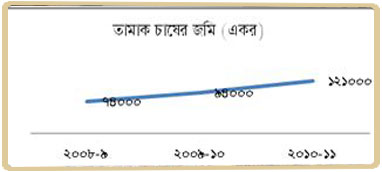
 জনস্বাস্থ্য সবার উপরে Public Health On Top
জনস্বাস্থ্য সবার উপরে Public Health On Top
 মৃত্যু বিপণন-১ Death Marketing-1
মৃত্যু বিপণন-১ Death Marketing-1
 মৃত্যু বিপণন-২ Death Marketing-2
মৃত্যু বিপণন-২ Death Marketing-2
 Death Marketing Around
Death Marketing Around

Death Marketing-1
Tobacco companies’ death-marketing entraps simple farmers

Gradually the croplands, reserved and fallow lands of government are turning to tobacco-lands, and the issue is prioritized on media recently. Analysis of the reports expose that the death-seller tobacco companies are trickily grabbing the growers in the death-trap. Based on the simplicity of the farmers, tobacco companies allure them in different ways and engage them in the malicious farming cycle of the toxic plant which is liable for the rapid expansion of countrywide tobacco farming. Yearbook of Agricultural Statistics of Bangladesh 2011 also bears the testimony (see the graph).
Not only the tobacco companies are peddling death by violating and using the loopholes of the Smoking and Tobacco Product Usage (Control) (Amended) Act 2013, they are adopting different mean modes to expand tobacco cultivation across the nation as well. Analysis of the recently published news over tobacco cultivation represents the following immoral methods by tobacco industries:
• The tobacco industry distributes agri-inputs like fertilizers, seeds, pesticides etc. among the farmers to grow tobacco.
• Tobacco companies provide soft-loans, advance money and even provide loan by taking signature on blank non-judicial stamps
• They assure the farmers to buy tobacco leaves with attractive prices and inspire them by deciding an advance price which works as a stimulator of profit among the farmers.
• Likewise providing financial feedbacks, tobacco industry officials publicize among the farmers that tobacco farming needs less irrigation and manures, there is no diseases in tobacco farming and it is more profitable than other crops like paddy production. Further, they run door to door campaign among the farmers to inspire them in tobacco growing and share information over the modernized tobacco cultivation methods.
• Landlords are more interested in leasing of lands with the tobacco makers for the profit differentials. They get Tk 12,000 for a year by leasing 40 decimal lands for food-crop cultivation whereas it brings Tk 25-30 thousands if that is rented as tobacco land. Thereby, tobacco is dominating on the lands while food-crops are deficient of lands to grow up, and the poor farmers, particularly who are landless, turn bound to grow tobacco.
The ill-tactics of tobacco industries are increasing aggressively among the farmers of the greater Rangpur district, river banks of the high land (hill tracts) area and sandy lands of the Jessore, Kushtia, Meherpur, Jhenidah and Chuadanga districts day by day that has produced tobacco on around 148,000 hectares of lands which is 38,000 hectares more than last season. The media reports assume that the crop lands in those areas will diminish soon provided that for the failure to prevent tobacco aggression in the areas.
